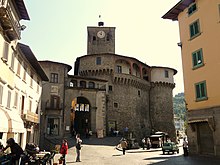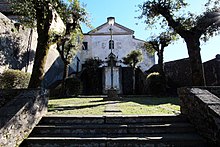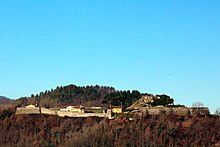Castelnuovo di Garfagnana
| Castelnuovo di Garfagnana | ||
|---|---|---|

|
|
|
| Country | Italy | |
| region | Tuscany | |
| province | Lucca (LU) | |
| Coordinates | 44 ° 7 ' N , 10 ° 24' E | |
| height | 270 m slm | |
| surface | 28.5 km² | |
| Residents | 5,826 (Dec. 31, 2019) | |
| Population density | 204 inhabitants / km² | |
| Post Code | 55032 | |
| prefix | 0583 | |
| ISTAT number | 046009 | |
| Popular name | Castelnuovesi | |
| Patron saint | SS. Pietro e Paulo (June 29) | |
| Website | Castelnuovo di Garfagnana | |
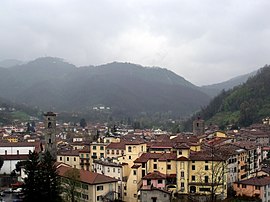 View of Castelnuovo di Garfagnana |
||
Castelnuovo di Garfagnana is an Italian municipality with 5826 inhabitants (as of December 31, 2019) in the province of Lucca in Tuscany . It is the main town of the Garfagnana .
geography
The municipality is located in the Garfagnana countryside about 30 km north of the provincial capital Lucca and about 77 km northwest of the regional capital Florence in the climatic classification of Italian municipalities in zone E, 2 234 GG. The center of Castelnuovo di Garfagnana is located in the upper Serchio Valley at the tributary of the Torrente Turrite Secca (9 of 21 km in the municipality, right tributary) into the Serchio River (9 of 106 km in the municipality) west of the Serchio (right side) and north of the Turrite Secca .
The municipal area includes the districts (Frazioni) Antisciana (407 m, approx. 100 inhabitants), Cerretoli (535 m, approx. 70 inhabitants), Colle (727 m, approx. 50 inhabitants), Gragnanella (498 m, approx. 80 inhabitants) ), Croce - Stazzana (894 m, approx. 60 inhabitants), Metello (850 m, approx. 20 inhabitants), Monterotondo (481 m, approx. 15 inhabitants), Palleroso (511 m, approx. 85 inhabitants) and Rontano ( 633 m, approx. 50 inhabitants). The main town Castelnuovo di Garfagnana has about 5000 inhabitants.
The neighboring municipalities are Camporgiano , Careggine , Fosciandora , Gallicano , Molazzana and Pieve Fosciana .
history

The place was first mentioned in 740 in a document from the Archdiocese of Lucca . In 991 Gherardo, Bishop of Lucca , assigned the place to the Gherardinghi (Conti della Verruca). At the end of the 13th century Lucca was able to take the place and had the place fortified by Castruccio Castracani . A few years later, the Rocca was strengthened by Paolo Guinigi and the tower was built. In 1430 the place was at the center of the conflict between Florence and Lucca and looked to Niccolò III. d'Este from the family of Este of Ferrara protection. In 1512 the place was occupied by Francesco Maria I della Rovere , who, however, could not take the Rocca. From 1521 the Medici from Florence ruled the place, but after the death of their Pope Leo X in the same year the place went back to the Este, who were led here by Alfonso I d'Este . Ludovico Ariosto was the governor from 1522 to 1525 . The rule of the Estonians lasted until the time of the occupation of Italy by Napoleon Bonaparte . During this time his sister, Elisa Baciocchi , ruled the Garfagnana. After Napoleon's defeat, the place returned to Modena in 1814 .
Attractions
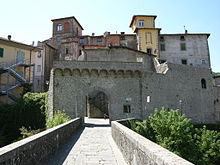
- Rocca Ariostesca , 11th century fortifications within the city walls. It was named after Ludovico Ariosto.
- City walls from the late 13th century, created by Castruccio Castracani, with the city gates:
- Porta Calcinaia , city gate at the Rocca Ariostesca.
- Porta Vecchia , today only partially existing city gate.
- Porta di Castruccio , also Porta Miccia or Porta di Santa Lucia called
- Duomo dei Santi Pietro e Paolo , main church within the city walls. The Church of San Pietro was built before 740 and was under the Pieve in Pieve Fosciana until 1398 . In 1504 the cathedral was rebuilt. It contains the canvas painting Assunzione by Santi di Tito and the work Madonna con i Santi Giacomo e Andrea by Giovanni Antonio Sogliani .
- Ponte di Castruccio , also called Ponte Santa Lucia , bridge over the Serchio, which is adjacent to Porta Castruccio.
- Madonna del Ponte , church on the bridge of the Serchio on the left side of the river.
- Palazzo Azzi
- Teatro Alfieri , a theater created in 1860 by Giovanni Carli and Antonio Vittoni on the left side of the Serchio, which was named after Vittorio Alfieri . The first performance took place on August 22, 1860, when the opera La straniera by Vincenzo Bellini was performed.
- Convento dei Cappuccini ( Cappuccini del Monte Calvario ), monastery on the left side of the Serchio just outside the city walls. Created in 1635 by Alfonso III. d'Este , who also died here and found his last rest.
- Fortezza di Mont'Alfonso (also spelled Montalfonso ), fortification with seven defense towers. It lies above the village at 453 m and was created in 1579 by Alfonso II. D'Este over the remains of an older complex.
- Chiesa di San Prospero , church in the district of Antisciana, which was already mentioned in 1168 in a document from Pope Alexander III. was documented.
- Rocca di Antisciana , former castle in the district of Antisciana. Today only the remains of the castle and the fortification walls can be seen.
- Chiesa di San Michele Arcangelo , already mentioned around 1178 church in the district of Colle.
- Chiesa di San Bartolomeo , church in the Gragnanella district. Documented as early as 1168.
- Chiesa dei Santi Martino e Rocco , church in the Palleroso district. Also mentioned in 1168.
- Castello di Palleroso , fortifications in the Palleroso district. Already mentioned in 1376 as Castrum Pallarosi in a document from Charles IV . Today only as a ruin with parts of the tower and parts of the defensive wall with gate.
- Oratorio di San Rocco , oratorio in the Palleroso district.
- Chiesa di San Donato , already mentioned in 1168 church in the district of Rontano.
Personalities
- Giovanni Di Lorenzo (* 1993), football player
- Jasmine Paolini (* 1996), tennis player
literature
- Emanuele Repetti: CASTELNUOVO DI GARFAGNANA nella Valle superiore del Serchio. In: Dizionario Geografico Fisico Storico della Toscana (1833–1846), online edition of the University of Siena (pdf, Italian)
- Touring Club Italiano : Toscana. Milan 2003, ISBN 88-365-2767-1 , p. 217 ff.
Web links
- Official website of the municipality of Castelnuovo di Garfagnana (Italian)
- Website of the Pro Loco in Castelnuovo di Garfagnana (Italian)
Individual evidence
- ↑ Statistiche demografiche ISTAT. Monthly population statistics of the Istituto Nazionale di Statistica , as of December 31 of 2019.
- ↑ Website of the Agenzia nazionale per le nuove tecnologie, l'energia e lo sviluppo economico sostenibile (ENEA) , accessed on February 14, 2016 (Italian) (PDF; 330 kB)
- ↑ a b c d Emanuele Repetti: CASTELNUOVO DI GARFAGNANA nella Valle superiore del Serchio.
- ↑ Official website of the Sistema Informativo Ambientale della Regione Toscana (SIRA) on the rivers in Castelnuovo di Garfagnana , accessed on February 14, 2016 (Italian)
- ↑ Official website of the ISTAT ( Istituto Nazionale di Statistica ) on the districts and population figures 2001 in the province of Lucca, accessed on February 14, 2016 (Italian)
- ↑ a b Contado Lucchese: Castelnuovo Garfagnana. Retrieved February 15, 2016 (Italian)
- ↑ a b c d e Touring Club Italiano: Toscana.
- ↑ Arcidiocesi di Lucca to the Duomo dei Santi Pietro e Paolo in Castelnuovo di Garfagnana ( Memento of the original from February 15, 2016 in the Internet Archive ) Info: The archive link was inserted automatically and has not yet been checked. Please check the original and archive link according to the instructions and then remove this notice. , Website of the Archdiocese of Lucca , accessed on February 14, 2016 (Italian)
- ↑ Official website of the Teatro Alfieri , accessed on February 15, 2016 (Italian)
- ↑ Arcidiocesi di Lucca to the Chiesa San Prospero in Antisciana ( Memento of the original from February 15, 2016 in the Internet Archive ) Info: The archive link was inserted automatically and has not yet been checked. Please check the original and archive link according to the instructions and then remove this notice. , Website of the Archdiocese of Lucca, accessed on February 14, 2016 (Italian)
- ^ A b Contado Lucchese: I borghi di Castelnuovo di Garfagnana. Retrieved February 15, 2016 (Italian)
- ↑ Arcidiocesi di Lucca to the Chiesa San Michele in Colle ( Memento of the original from February 15, 2016 in the Internet Archive ) Info: The archive link was inserted automatically and has not yet been checked. Please check the original and archive link according to the instructions and then remove this notice. , Website of the Archdiocese of Lucca, accessed on February 14, 2016 (Italian)
- ↑ Arcidiocesi di Lucca to the Chiesa San Bartolomeo in Gragnanella ( Memento of the original from February 15, 2016 in the Internet Archive ) Info: The archive link was inserted automatically and has not yet been checked. Please check the original and archive link according to the instructions and then remove this notice. , Website of the Archdiocese of Lucca, accessed on February 14, 2016 (Italian)
- ↑ Arcidiocesi di Lucca for the Chiesa Martino e Rocco in Palleroso ( Memento of the original from February 15, 2016 in the Internet Archive ) Info: The archive link was inserted automatically and has not yet been checked. Please check the original and archive link according to the instructions and then remove this notice. , Website of the Archdiocese of Lucca, accessed on February 14, 2016 (Italian)
- ↑ Arcidiocesi di Lucca to the Chiesa San Donato in Rontano ( Memento of the original from February 15, 2016 in the Internet Archive ) Info: The archive link was inserted automatically and has not yet been checked. Please check the original and archive link according to the instructions and then remove this notice. , Website of the Archdiocese of Lucca, accessed on February 14, 2016 (Italian)


